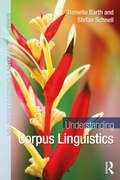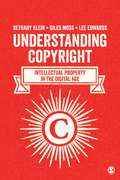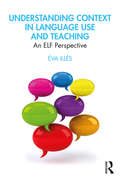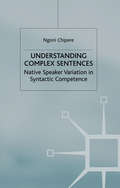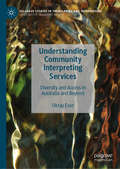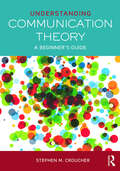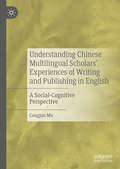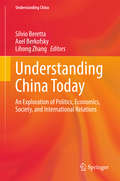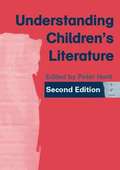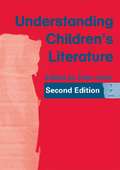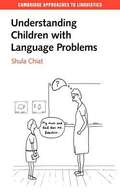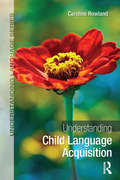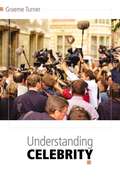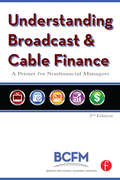- Table View
- List View
Understanding Corpus Linguistics (Understanding Language)
by Danielle Barth Stefan SchnellThis textbook introduces the fundamental concepts and methods of corpus linguistics for students approaching this topic for the first time, putting specific emphasis on the enormous linguistic diversity represented by approximately 7,000 human languages and broadening the scope of current concerns in general corpus linguistics. Including a basic toolkit to help the reader investigate language in different usage contexts, this book: Shows the relevance of corpora to a range of linguistic areas from phonology to sociolinguistics and discourse Covers recent developments in the application of corpus linguistics to the study of understudied languages and linguistic typology Features exercises, short problems, and questions Includes examples from real studies in over 15 languages plus multilingual corpora Providing the necessary corpus linguistics skills to critically evaluate and replicate studies, this book is essential reading for anyone studying corpus linguistics.
Understanding Corpus Linguistics (Understanding Language)
by Danielle Barth Stefan SchnellThis textbook introduces the fundamental concepts and methods of corpus linguistics for students approaching this topic for the first time, putting specific emphasis on the enormous linguistic diversity represented by approximately 7,000 human languages and broadening the scope of current concerns in general corpus linguistics. Including a basic toolkit to help the reader investigate language in different usage contexts, this book: Shows the relevance of corpora to a range of linguistic areas from phonology to sociolinguistics and discourse Covers recent developments in the application of corpus linguistics to the study of understudied languages and linguistic typology Features exercises, short problems, and questions Includes examples from real studies in over 15 languages plus multilingual corpora Providing the necessary corpus linguistics skills to critically evaluate and replicate studies, this book is essential reading for anyone studying corpus linguistics.
Understanding Copyright: Intellectual Property in the Digital Age
by Giles Moss Lee Edwards Bethany KleinDigital technology has forever changed the way media is created, accessed, shared and regulated, raising serious questions about copyright for artists and fans, media companies and internet intermediaries, activists and governments. Taking a rounded view of the debates that have emerged over copyright in the digital age, this book: Looks across a broad range of industries including music, television and film to consider issues of media power and policy. Features engaging examples that have taken centre stage in the copyright debate, including high profile legal cases against Napster and The Pirate Bay, anti-piracy campaigns, the Creative Commons movement, and public protests against the expansion of copyright enforcement. Considers both the dominant voices, such as industry associations, and those who struggle to be heard, including ordinary media users, drawing on important studies into copyright from around the world. Offering media students and scholars a comprehensive overview of the contemporary issues surrounding intellectual property through the struggle over copyright, Understanding Copyright explores why disagreement is rife and how the policymaking process might accommodate a wider range of views.
Understanding Context in Language Use and Teaching: An ELF Perspective
by Éva IllésThis book is a guide to understanding and applying the essential, heretofore elusive, notion of context in language study and pedagogy. Éva Illés offers a new, critical, systematic theoretical framework, then applies that framework to practical interactions and issues in communicative language teaching rooted in English as a Lingua Franca. By linking theory and practice for research and teaching around the world, this book brings a new awareness of how context can be conceptualised and related to language pedagogy to advanced students, teachers, teacher educators and researchers of language teaching, applied linguistics and pragmatics.
Understanding Context in Language Use and Teaching: An ELF Perspective
by Éva IllésThis book is a guide to understanding and applying the essential, heretofore elusive, notion of context in language study and pedagogy. Éva Illés offers a new, critical, systematic theoretical framework, then applies that framework to practical interactions and issues in communicative language teaching rooted in English as a Lingua Franca. By linking theory and practice for research and teaching around the world, this book brings a new awareness of how context can be conceptualised and related to language pedagogy to advanced students, teachers, teacher educators and researchers of language teaching, applied linguistics and pragmatics.
Understanding Complex Sentences: Native Speaker Variation in Syntactic Competence
by N. ChipereIs native speaker variation in understanding complex sentences due to individual differences in working memory capacity or in syntactic competence? The answer to this question has very important consequences for both theoretical and applied concerns in linguistics and education. This book is distinctive in giving an historical and interdisciplinary perspective on the rule- based and experience-based debate and in supporting an integrated account. In the study reported here, variation was found to be due to differences in syntactic competence and the author argues that sentence comprehension is a learned skill, displaying many of the general characteristics of cognitive skills. The book will be stimulating reading for psycholinguists, theoretical linguists, applied linguists and educators.
Understanding Community Interpreting Services: Diversity and Access in Australia and Beyond (Palgrave Studies in Translating and Interpreting)
by Oktay EserThis book investigates community interpreting services as a market offering that satisfies the needs of Culturally and Linguistically Diverse (CALD) members of the Australian community, with an additional chapter on the Turkish context. Bringing together the disciplines of interpreting studies and management, the author analyses a variety of challenges which still arise in various fields of interpreting and suggest possible solutions, as well as future directions for other global contexts where changing demographics mean that community-based interpreting is increasingly relevant. Based on interviews with various stakeholders including directors, interpreters, and trainers in the private sector or state-run institutions, the book's main focus is the real experiences of people working on the ground in community interpreting. This book will be of interest to students and scholars of translation, interpreting and migration studies, as well as interpreters and their trainers, and government policy-makers.
Understanding Communication Theory: A Beginner's Guide
by Stephen M. CroucherThis book offers students a comprehensive, theoretical, and practical guide to communication theory. Croucher defines the various perspectives on communication theory—the social scientific, interpretive, and critical approaches—and then takes on the theories themselves, with topics including interpersonal communication, organizational communication, intercultural communication, persuasion, critical and rhetorical theory and other key concepts. Each theory chapter includes a sample undergraduate-written paper that applies the described theory, along with edits and commentary by Croucher, giving students an insider’s glimpse of the way communication theory can be written about and applied in the classroom and in real life. Featuring exercises, case studies and keywords that illustrate and fully explain the various communication theories, Understanding Communication Theory gives students all the tools they need to understand and apply prominent communication theories.
Understanding Communication Theory: A Beginner's Guide
by Stephen M. CroucherThis book offers students a comprehensive, theoretical, and practical guide to communication theory. Croucher defines the various perspectives on communication theory—the social scientific, interpretive, and critical approaches—and then takes on the theories themselves, with topics including interpersonal communication, organizational communication, intercultural communication, persuasion, critical and rhetorical theory and other key concepts. Each theory chapter includes a sample undergraduate-written paper that applies the described theory, along with edits and commentary by Croucher, giving students an insider’s glimpse of the way communication theory can be written about and applied in the classroom and in real life. Featuring exercises, case studies and keywords that illustrate and fully explain the various communication theories, Understanding Communication Theory gives students all the tools they need to understand and apply prominent communication theories.
Understanding Chinese Multilingual Scholars’ Experiences of Writing and Publishing in English: A Social-Cognitive Perspective
by Congjun MuThis book analyses the English writing and publishing experiences of 118 scholars from 18 Chinese universities from a social-cognitive perspective. It addresses the challenges and strategies multilingual scholars, particularly Chinese academics, reported in the process of writing and publishing in English. This allows the author to present a taxonomy of journal article writing strategies that correspond to the lived experiences of scholars in China, but which can also be applied to other contexts in the world. This book offers a step-by-step analysis of ethnographic case studies, insights and implications for teaching practice, as well as suggested directions for future research. It will be of particular interest to scholars in the fields of ERPP (English for Research Publication Purposes) as well as students and scholars of applied linguistics more broadly.
Understanding China Today: An Exploration of Politics, Economics, Society, and International Relations (Understanding China)
by Silvio Beretta Axel Berkofsky Lihong ZhangThis book covers numerous areas and aspects of Chinese domestic and external politics and policies, the Chinese economy, Chinese society and culture, and Chinese literature and history. It is divided into four sections, the first of which focuses on China’s place in world politics, including its relations with the European Union, Russia, India, Japan, the United States, and Africa. The second section among others addresses issues and areas related to China’s role in and impact on the international economy, the strategies and positioning of Chinese multinational companies investing in Europe, the problems and challenges of China's banking and financial systems and China's foreign economic strategies. The final two sections are devoted to Chinese politics and society, and Italian views on Chinese culture, language, and literature. The volume is multidisciplinary in nature, with contributions from experts of politics, economics, history, law, literature, gender studies, and the media. It will appeal to a wide range of China scholars and analysts as well as to all who have an interest in international relations, Chinese politics, the Chinese economy, and Chinese society, culture, literature, and history.
Understanding Children's Literature (PDF)
by Peter HuntPresenting a systematic introduction to the essential concepts necessary for the study of children's literature, this book guides the reader through the most relevant areas of criticism and theory, summarizing their contexts and applications. Bibliographies provide details of further information sources and a glossary explains the literary terms encountered in the book. Compiled by one of the leading editors in the field, this exhaustive work is an invaluable and user-friendly guide for readers involved in both literature and education. 9780415375474 9780203968963
Understanding Children's Literature
by Peter HuntPresenting a systematic introduction to the essential concepts necessary for the study of children's literature, this book guides the reader through the most relevant areas of criticism and theory, summarizing their contexts and applications. Bibliographies provide details of further information sources and a glossary explains the literary terms encountered in the book. Compiled by one of the leading editors in the field, this exhaustive work is an invaluable and user-friendly guide for readers involved in both literature and education. 9780415375474 9780203968963
Understanding Children's Literature: Key Essays From The International Companion Encyclopedia Of Children's Literature
by Peter HuntEdited by Peter Hunt, a leading figure in the field, this book introduces the study of children’s literature, addressing theoretical questions as well as the most relevant critical approaches to the discipline. The fourteen chapters draw on insights from academic disciplines ranging from cultural and literary studies to education and psychology, and include an essay on what writers for children think about their craft. The result is a fascinating array of perspectives on key topics in children’s literature as well as an introduction to such diverse concerns as literacy, ideology, stylistics, feminism, history, culture and bibliotherapy. An extensive general bibliography is complemented by lists of further reading for each chapter and a glossary defines critical and technical terms, making the book accessible for those coming to the field or to a particular approach for the first time. In this second edition there are four entirely new chapters; contributors have revisited and revised or rewritten seven of the chapters to reflect new thinking, while the remaining three are classic essays, widely acknowledged to be definitive. Understanding Children’s Literature will not only be an invaluable guide for students of literature or education, but it will also inform and enrich the practice of teachers and librarians.
Understanding Children's Literature
by Peter HuntEdited by Peter Hunt, a leading figure in the field, this book introduces the study of children’s literature, addressing theoretical questions as well as the most relevant critical approaches to the discipline. The fourteen chapters draw on insights from academic disciplines ranging from cultural and literary studies to education and psychology, and include an essay on what writers for children think about their craft. The result is a fascinating array of perspectives on key topics in children’s literature as well as an introduction to such diverse concerns as literacy, ideology, stylistics, feminism, history, culture and bibliotherapy. An extensive general bibliography is complemented by lists of further reading for each chapter and a glossary defines critical and technical terms, making the book accessible for those coming to the field or to a particular approach for the first time. In this second edition there are four entirely new chapters; contributors have revisited and revised or rewritten seven of the chapters to reflect new thinking, while the remaining three are classic essays, widely acknowledged to be definitive. Understanding Children’s Literature will not only be an invaluable guide for students of literature or education, but it will also inform and enrich the practice of teachers and librarians.
Understanding Children's Books: A Guide for Education Professionals (PDF)
by Ms Prue GoodwinChildren's books play a vital role in education, and this book helps you to choose books that have the most to offer young children. Each chapter reflects on a different theme or genre and their role in educational settings, and recommends ten 'must reads' within each one. The themes covered include: - books for babies - literature for the very young - narrative fiction - books in translation - poetry - picture books - graphic texts. Early years professionals, childcare professionals and teachers working from nursery to Key Stage 3 will find this book a fascinating and useful resource.
Understanding Children's Books: A Guide for Education Professionals
by Ms Prue GoodwinChildren's books play a vital role in education, and this book helps you to choose books that have the most to offer young children. Each chapter reflects on a different theme or genre and their role in educational settings, and recommends ten 'must reads' within each one. The themes covered include: - books for babies - literature for the very young - narrative fiction - books in translation - poetry - picture books - graphic texts. Early years professionals, childcare professionals and teachers working from nursery to Key Stage 3 will find this book a fascinating and useful resource.
Understanding Children With Language Problems (Cambridge Approaches To Linguistics Ser. (PDF))
by Shula ChiatSome children can hear and can speak, yet have trouble understanding or producing utterances. In this accessible introduction to children's language difficulties, Shula Chiat explores the stumbling blocks which lie behind their struggle. The uniqueness of this book lies in its focus on individual children, the extensive and intriguing examples which illustrate their problems, and the step-by-step search for the source of those problems. Difficulties with words, verb structures, function morphomenes, and meaning are examined and illustrated by detailed case studies. This book provides a clear overview of what children with language difficulties say and do, and introduces a logical approach to identifying children's language problems. It will be welcomed by students and researchers of linguistics, language development and language disorders; teachers of language-impaired children; and speech and language therapists.
Understanding Child Language Acquisition
by Caroline RowlandTaking an accessible and cross-linguistic approach, Understanding Child Language Acquisition introduces readers to the most important research on child language acquisition over the last fifty years, as well as to some of the most influential theories in the field. Rather than just describing what children can do at different ages Rowland explains why these research findings are important and what they tell us about how children acquire language. Key features include: Cross-linguistic analysis of how language acquisition differs between languages A chapter on how multilingual children acquire several languages at once Exercises to test comprehension Chapters organised around key questions that summarise the critical issues posed by researchers in the field, with summaries at the end Further reading suggestions to broaden understanding of the subject With its particular focus on outlining key similarities and differences across languages and what this cross-linguistic variation means for our ideas about language acquisition, Understanding Child Language Acquisition forms a comprehensive introduction to the subject for students of linguistics, psychology and speech and language therapy. Students and instructors will benefit from the comprehensive companion website that includes a students’ section featuring interactive comprehension exercises, extension activities, chapter recaps and answers to the exercises within the book. Material for instructors includes sample essay questions, answers to the extension activities for students and a Powerpoint including all the figures from the book. www.routledge.com/cw/rowland
Understanding Child Language Acquisition
by Caroline RowlandTaking an accessible and cross-linguistic approach, Understanding Child Language Acquisition introduces readers to the most important research on child language acquisition over the last fifty years, as well as to some of the most influential theories in the field. Rather than just describing what children can do at different ages Rowland explains why these research findings are important and what they tell us about how children acquire language. Key features include: Cross-linguistic analysis of how language acquisition differs between languages A chapter on how multilingual children acquire several languages at once Exercises to test comprehension Chapters organised around key questions that summarise the critical issues posed by researchers in the field, with summaries at the end Further reading suggestions to broaden understanding of the subject With its particular focus on outlining key similarities and differences across languages and what this cross-linguistic variation means for our ideas about language acquisition, Understanding Child Language Acquisition forms a comprehensive introduction to the subject for students of linguistics, psychology and speech and language therapy. Students and instructors will benefit from the comprehensive companion website that includes a students’ section featuring interactive comprehension exercises, extension activities, chapter recaps and answers to the exercises within the book. Material for instructors includes sample essay questions, answers to the extension activities for students and a Powerpoint including all the figures from the book. www.routledge.com/cw/rowland
Understanding Celebrity (PDF)
by Professor Graeme Turner`Graeme Turner is one of the leading figures in cultural studies today. When his gaze turns to celebrity, the result is a readable and compelling account of this most perplexing and infuriating of modern phenomena. Read on!' - Toby Miller, New York University We cannot escape celebrity culture: it is everywhere. So just what is the cultural function of celebrity? This is the first comprehensive overview of the production and consumption of celebrity from within cultural and media studies. The pervasive influence of contemporary celebrity, and the cultures it produces, has been widely noticed. Earlier studies, though, have tended to focus on the consumption of celebrity or on particular locations of celebrity - Hollywood, or the sports industries for instance. This book presents a broad survey across all media as well as a new synthesis of theoretical positions, that will be welcomed by all students of media and cultural studies. Among its attributes are the following: -It provides an overview and evaluation of the key debates surrounding the definition of celebrity, its history, and its social and cultural function -It examines the 'celebrity industries’: the PR and publicity structures that manufacture celebrity -It looks at the cultural processes through which celebrity is consumed -It draws examples from the full range of contemporary media - film, television, newspapers, magazines and the web
Understanding The Call of the Wild: A Student Casebook to Issues, Sources, and Historical Documents (The Greenwood Press "Literature in Context" Series)
by Claudia Durst JohnsonLondon's adventure tale The Call of the Wild explores the complex relationships between man and nature, and animals' struggle with their own nature in man's world. In this interdisciplinary study, a rich collection of primary documents point out the many issues that make this story as poignant and pertinent today as when it was written nearly a century ago. Compiled here for the first time is documentation from sources as varied as century-old newspaper accounts, legislative materials, advertisements, poetry, journals, and other startling firsthand accounts. The story's historical setting, the Yukon Gold Rush, is brought vividly into focus for readers, with firsthand accounts of the unimaginable hardships faced by the prospectors in the Klondike and Alaskan Gold Fields. Central to their story and to their very survival were the dogs that served man's ambitions. Tribute to the sled dog is given in an historical 1879 piece The Value of Dogs from the Sketches of Life in the Hudson Bay Territory. This casebook also investigates endangered species legislation and the history of animal welfare concerns, focusing on the treatment of dogs in particular, surveying over a century of public sentiment.Students are introduced to The Call of the Wild with an insightful literary analysis exploring a mythological interpretation and a discussion of its main thematic premise, the fundamental struggle for freedom. Each subsequent chapter of this casebook focuses on an important topic, such as animal welfare, contextualizing these issues with primary documents. Students will find these materials and the related essays invaluable in understanding not only The Call of the Wild but also the historical and pertinent social issues it addresses. Each topic section of this casebook offers ideas for thought-provoking class discussions, debates, and further research. Suggestions for further reading on these topics are also given.
Understanding Broadcast and Cable Finance: A Primer for the Non-Financial Manager
by Broadcast Cable Financial ManaFrom on-air talent contracts and FCC regulations to syndicated program amortization to music licensing fees, electronic media deal with financial principles and jargon that are unique to American business. Understanding Broadcast and Cable Finance helps explain all the financial complexities of a modern electronic media enterprise. Whether you are a news director, sales manager, engineer or any other non-accounting professional that has a stake in the success of your company, this book will bring you up-to-speed on the essentials of financial management for broadcasting and cable.
Understanding Broadcast and Cable Finance: A Primer for the Non-Financial Manager
by Broadcast Cable Financial ManaFrom on-air talent contracts and FCC regulations to syndicated program amortization to music licensing fees, electronic media deal with financial principles and jargon that are unique to American business. Understanding Broadcast and Cable Finance helps explain all the financial complexities of a modern electronic media enterprise. Whether you are a news director, sales manager, engineer or any other non-accounting professional that has a stake in the success of your company, this book will bring you up-to-speed on the essentials of financial management for broadcasting and cable.
Understanding Blanchot, Understanding Modernism (Understanding Philosophy, Understanding Modernism)
by Christopher LangloisMaurice Blanchot occupies a central though still-overlooked position in the Anglo-American reception of 20th-century continental philosophy and literary criticism. On the one hand, his rigorous yet always-playful exchanges with the most challenging figures of the philosophical and literary canons of modernity have led thinkers such as Georges Bataille, Emmanuel Levinas, Jacques Derrida, and Michel Foucault to acknowledge Blanchot as a major influence on the development of literary and philosophical culture after World War II. On the other hand, Blanchot's reputation for frustrating readers with his difficult style of thought and writing has resulted in a missed opportunity for leveraging Blanchot in advancing the most essential discussions and debates going on today in the comparative study of literature, philosophy, politics, history, ethics, and art. Blanchot's voice is simply too profound, too erudite, and too illuminating of what is at stake at the intersections of these disciplines not to be exercising more of an influence than it has in only a minority of intellectual circles. Understanding Blanchot, Understanding Modernism brings together an international cast of leading and emergent scholars in making the case for precisely what contemporary modernist studies stands to gain from close inspection of Blanchot's provocative post-war writings.
